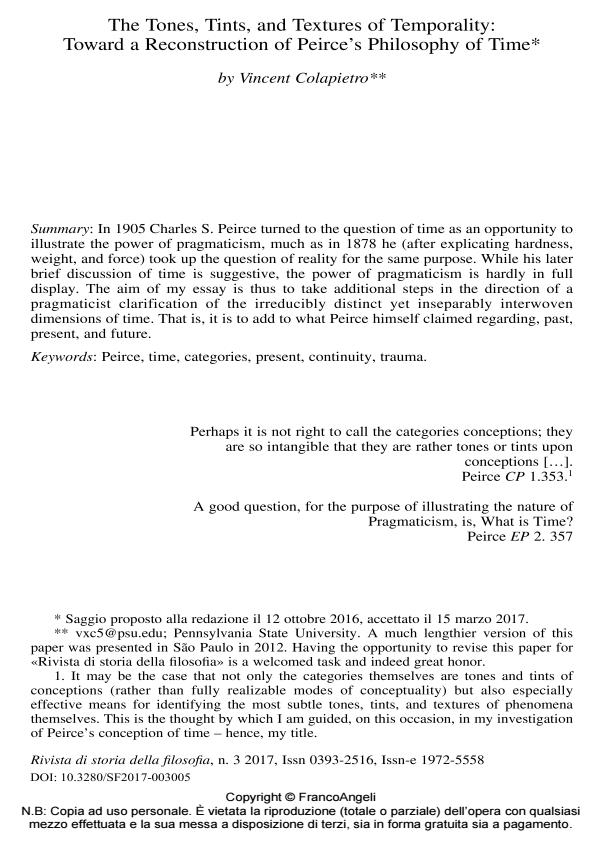The Tones, Tints, and Textures of Temporality: Toward a Reconstruction of Peirce's Philosophy of Time
Journal title RIVISTA DI STORIA DELLA FILOSOFIA
Author/s Vincent Colapietro
Publishing Year 2017 Issue 2017/3 Language English
Pages 19 P. 435-453 File size 20987 KB
DOI 10.3280/SF2017-003005
DOI is like a bar code for intellectual property: to have more infomation
click here
Below, you can see the article first page
If you want to buy this article in PDF format, you can do it, following the instructions to buy download credits

FrancoAngeli is member of Publishers International Linking Association, Inc (PILA), a not-for-profit association which run the CrossRef service enabling links to and from online scholarly content.
In 1905 Charles S. Peirce turned to the question of time as an opportunity to illustrate the power of pragmaticism, much as in 1878 he (after explicating hardness, weight, and force) took up the question of reality for the same purpose. While his later brief discussion of time is suggestive, the power of pragmaticism is hardly in full display. The aim of my essay is thus to take additional steps in the direction of a pragmaticist clarification of the irreducibly distinct yet inseparably interwoven dimensions of time. That is, it is to add to what Peirce himself claimed regarding, past, present, and future.
Keywords: Peirce, time, categories, present, continuity, trauma.
- Burbidge 1981: John W. Burbidge, Peirce on Historical Explanation, in L. W. Sumner et al. (eds.), Pragmatism and Purpose, University of Toronto Press, Toronto 1981, pp. 15-27.
- Colapietro 2003: Vincent Colapietro, The Space of Signs, in Dale Jacquette (ed.), Philosophy, Psychology, and Psychologism, Kluwer, New York 2003.
- Darwin 1969: Charles Darwin, The Autobiography of Charles Darwin and Selected Letters, Dover Publications, New York 1969.
- Esposito 1983: Joseph L. Esposito, Peirce and the Philosophy of History, , 192 (1983), pp. 55-65.
- Grünbaum 1967: Adolf Grünbaum, The Status of Temporal Becoming, in Richard Gale (ed.), The Philosophy of Time, Anchor Books, Garden City (NY) 1967.
- Havenel 2008: Jérôme Havenel, Peirce Clarifications of Continuity, , 44 (2008), 1, pp. 86-133.
- Helm 1980: Bertrand Helm, The Nature and Modes of Time, , 63 (1980), 3, pp. 375-385.
- Helm 1985: Id., Time and Reality in American Philosophy, University of Massachusetts Press, Amherst (MA) 1985.
- Hoffmann, Dukas 1972: Banesh Hoffmann, Helen Dukas, Albert Einstein: Creator and Rebel, Viking Press, New York 1972.
- Kline 1986: George L. Kline, “Present”, “Past”, and “Future” as Categoreal Terms and the “Fallacy of the Actual Future”, 40 (1986), 2, pp. 215-235.
- LaCapra 1996: Dominick LaCapra, Representing the Holocaust: History, Theory, Trauma, Cornell University Press, Ithaca (NY) 1996.
- Miller 1978: Willard M. Miller, Peirce on Pragmatism and History, , 14 (1978) 1, pp. 42-52.
- Noble 1989: A. Brian Noble, Peirce’s Definitions of Continuity and the Concept of Possibility, , 25 (1989), 2, pp. 149-174.
- Peirce CP followed by volume and paragraph number: Charles Sanders Peirce, Collected Papers, vols. I-VI, Paul Weiss and Charles Hartshorne (eds.), Harvard University Press, Cambridge (MA) 1931-1935; vols. VII-VIII, Arthur W. Burks (ed.), Harvard University Press, Cambridge (MA) 1958.
- Peirce EP followed by volume and page number: Id., The Essential Peirce, vol. 1, Nathan Houser and Christian Kloesel (eds.); vol. 2, The Peirce Edition Project (ed.), Indiana University Press, Bloomington and Indianapolis 1992-1998.
- Roth 2011: Michael S. Roth, Memory, Trauma, and History: Essays on Living with the Past, Columbia University Press, New York 2011.
- Russell 1917: Bertrand Russell, Mysticism and Logic, Allen & Unwin, London 1917.
- Russell 1926: Id., Our Knowledge of the External World, Allen & Unwin, London 1926.
- Peirce e Leibniz Mariannina Failla, in European Journal of Pragmatism and American Philosophy /2019
DOI: 10.4000/ejpap.1555 - Temporal Synechism: A Peircean Philosophy of Time Jon Alan Schmidt, in Axiomathes /2022 pp.233
DOI: 10.1007/s10516-020-09523-6
Vincent Colapietro, The Tones, Tints, and Textures of Temporality: Toward a Reconstruction of Peirce's Philosophy of Time in "RIVISTA DI STORIA DELLA FILOSOFIA" 3/2017, pp 435-453, DOI: 10.3280/SF2017-003005